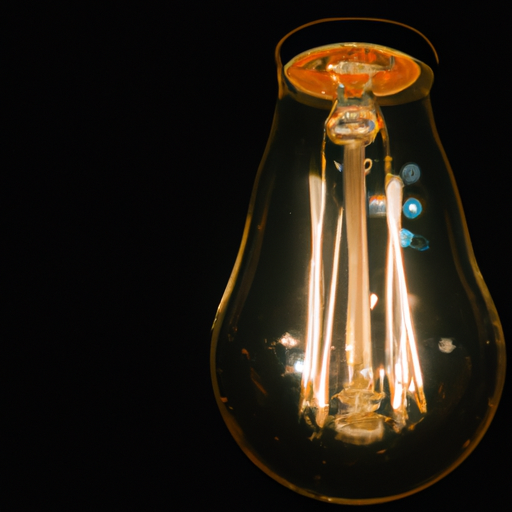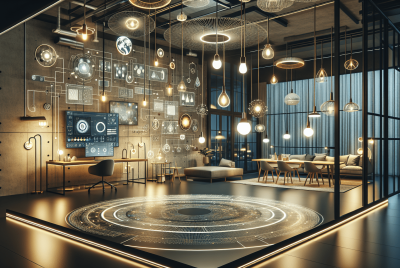Your LED Outdoor Lighting Guide
Picture this: you’re sitting in your cozy backyard on a warm summer night, sipping your favorite beverage and enjoying the company of loved ones. The sun sets, and suddenly, the darkness envelops your outdoor haven. But fear not! LED outdoor lighting is here to save the day (or night, rather). In this article, we will explore the world of LED outdoor lighting and provide you with all the essential information and advice you need to select the perfect lighting solution for your outdoor space. With LED technology, you can effortlessly enhance the ambiance, safety, and aesthetic appeal of your outdoor areas. Let’s dive into the world of LED outdoor lighting and transform your backyard into a magical oasis!
Benefits of LED Outdoor Lighting
Energy Efficiency
LED outdoor lighting is a popular choice among homeowners and businesses for several reasons, with energy efficiency being one of the key benefits. LED lights are designed to consume significantly less energy compared to traditional lighting sources such as incandescent or fluorescent bulbs. This means that LED outdoor lights can provide bright and vibrant illumination while consuming a fraction of the energy, helping you reduce your electricity costs and decrease your environmental footprint.
Long Lifespan
Another major advantage of LED outdoor lighting is its long lifespan. LEDs have an average lifespan of 50,000 to 100,000 hours, which is significantly longer than traditional bulbs. This means that once you install LED outdoor lights, you can enjoy many years of reliable illumination without the need for frequent replacements. The extended lifespan of LEDs not only saves you money on replacement bulbs but also reduces the hassle of maintenance and ensures that your outdoor areas remain well-lit throughout the year.
Environmental Friendliness
LED outdoor lighting is also known for its environmental friendliness. Unlike traditional lighting options, LED lights do not contain harmful substances such as mercury, making them a safer choice for both humans and the environment. Additionally, the energy efficiency of LED lights leads to a reduction in greenhouse gas emissions associated with electricity generation. By choosing LED outdoor lighting, you can contribute to a greener and more sustainable future while still enjoying bright and efficient illumination.
Types of LED Outdoor Lighting
LED Flood Lights
LED flood lights are a popular choice for illuminating large outdoor spaces such as driveways, parking lots, and gardens. These lights provide a powerful and broad beam of light, ensuring that your outdoor areas are well-lit and secure. LED flood lights come in various wattages and brightness levels, allowing you to find the perfect fit for your specific needs.
LED Pathway Lights
LED pathway lights are designed to illuminate pathways, walkways, and garden edges, providing both functional and aesthetic benefits. These lights are low-profile and can be easily installed along the edges of pathways, guiding people safely at night. LED pathway lights are available in various styles, including stake lights and bollards, allowing you to create a visually appealing and well-lit outdoor environment.
LED Solar Lights
LED solar lights are an excellent choice for environmentally-conscious individuals who want to harness the power of the sun to illuminate their outdoor spaces. These lights are equipped with solar panels that absorb sunlight during the day, converting it into energy to power the LED lights at night. LED solar lights are easy to install and require no wiring, making them a practical and cost-effective outdoor lighting solution.
LED String Lights
LED string lights are a versatile and decorative option for illuminating outdoor spaces. Whether you’re hosting a backyard party or simply want to add a cozy ambiance to your outdoor seating area, LED string lights can create a magical and inviting atmosphere. These lights come in various lengths and styles, allowing you to customize the lighting design to suit your specific preferences.
LED Wall Lights
LED wall lights are typically used for highlighting architectural features, accentuating outdoor artwork, or providing additional security around entrances and patios. These lights are installed directly on walls and come in a variety of styles, including uplights, downlights, and sconces. LED wall lights offer both functional and aesthetic benefits, enhancing the overall look and feel of your outdoor spaces.
Factors to Consider When Choosing LED Outdoor Lighting
Brightness
When selecting LED outdoor lighting, it’s important to consider the brightness level required for your specific application. The brightness of LED lights is measured in lumens, and different outdoor spaces may require varying levels of brightness. For example, pathway lights may require lower brightness compared to flood lights used for large outdoor areas. Consider the intended purpose and the amount of illumination needed when choosing the brightness level of your LED outdoor lights.
Color Temperature
Color temperature refers to the hue of light emitted by LED bulbs and is measured in Kelvin (K). Different color temperatures can create varying atmospheres and moods in outdoor spaces. Lower color temperatures (around 2700-3000K) emit a warm, cozy light ideal for creating a relaxed ambiance, while higher color temperatures (around 4000-5000K) produce a bright, white light suitable for security purposes. Consider the desired atmosphere and functionality when selecting the color temperature of your LED outdoor lights.
Beam Angle
Beam angle determines how wide or narrow the light is spread from the LED bulb. A wide beam angle is suitable for illuminating larger areas, while a narrow beam angle is ideal for focusing light on specific objects or areas. Consider the area you want to illuminate and the desired lighting effects when choosing the beam angle of your LED outdoor lights.
IP Rating
The IP (Ingress Protection) rating is an important factor to consider when selecting LED outdoor lighting. The IP rating indicates the level of protection against dust and water. For outdoor applications, it’s essential to choose lights with a high IP rating to ensure they can withstand various weather conditions. Look for lights with an IP65 or higher rating, which provide excellent protection against dust and water.
Design and Style
The design and style of LED outdoor lighting can greatly impact the overall aesthetics of your outdoor spaces. Whether you prefer a modern, sleek design or a more traditional look, there are numerous options available to suit your preferred style. Consider the existing design and theme of your outdoor area and choose LED lights that complement the overall aesthetic.
Installation Options
LED outdoor lighting is available in various installation options, including ground-mounted, wall-mounted, and hanging lights. Depending on your specific needs and preferences, you can select the most suitable installation method for your outdoor spaces. Consider factors such as accessibility, visibility, and practicality when choosing the installation options for your LED outdoor lights.
How to Calculate the Required Number of LED Outdoor Lights
Determine the Area to Be Illuminated
To calculate the required number of LED outdoor lights, start by determining the area that needs to be illuminated. Measure the length, width, and height of the outdoor space or the specific area you want to light up. This will give you the total area in square feet or square meters that needs to be illuminated.
Calculate the Lumen Requirement
Once you know the area to be illuminated, you can calculate the lumen requirement. The lumen is a unit that measures the amount of light emitted by a source. Different outdoor spaces require different lumen levels, depending on the desired brightness. As a general rule of thumb, you can use a lumen output of 10-20 lumens per square foot for outdoor lighting. Multiply the area in square feet by the desired lumen per square foot to calculate the total lumen requirement.
Choose the Appropriate Lighting Fixture
After determining the lumen requirement, you can select the appropriate lighting fixture based on the brightness level and beam angle needed. Consider the different types of LED outdoor lighting available and choose the fixture that meets your specific requirements. Remember to also consider factors such as color temperature, IP rating, and design when selecting your LED lighting fixture.
Installation Tips for LED Outdoor Lighting
Plan the Lighting Design
Before installing LED outdoor lighting, it’s important to plan the lighting design to ensure optimal placement and functionality. Consider the specific areas that require illumination, such as pathways, garden features, or entrances. Take into account the desired lighting effects, brightness levels, and overall aesthetics. By planning the lighting design beforehand, you can ensure that your outdoor spaces are properly lit and visually appealing.
Ensure Proper Wiring
Proper wiring is essential for the successful installation of LED outdoor lighting. Ensure that you have the necessary electrical knowledge and skills or seek professional assistance to ensure safe and effective wiring. Follow local electrical codes and regulations when installing outdoor lighting to prevent any safety hazards. Additionally, consider using low-voltage LED outdoor lighting systems, as they are easier to install and often do not require professional assistance.
Consider Photocell and Motion Sensor Features
Photocell and motion sensor features can enhance the functionality and energy efficiency of LED outdoor lighting. Photocells automatically turn the lights on at dusk and off at dawn, ensuring that your outdoor areas are always adequately illuminated without manual intervention. Motion sensors detect movement and automatically turn on the lights, providing enhanced security and saving energy by only activating the lights when needed. Consider incorporating these features into your LED outdoor lighting setup for added convenience and efficiency.
Maintenance and Care for LED Outdoor Lighting
Regular Cleaning
Regular cleaning is important to ensure the longevity and optimal performance of LED outdoor lighting. Over time, dust, dirt, and debris can accumulate on the light fixtures, reducing their brightness and effectiveness. To clean LED outdoor lights, gently wipe them with a soft, damp cloth or use a mild cleaning solution if needed. Avoid using abrasive materials or harsh chemicals that can damage the lights. Regular cleaning helps maintain the brightness and overall appearance of your LED outdoor lighting.
Checking for Damage
Periodically check your LED outdoor lighting for any signs of damage. Inspect the fixtures for cracks, loose connections, or any other visible damage that may affect their functionality. Check the wiring and connections to ensure they are secure and in good condition. Promptly replace any damaged or faulty components to prevent further issues and ensure the longevity of your LED outdoor lights.
Replacing Faulty Bulbs or Fixtures
If you notice any bulbs that are not working or fixtures that are no longer functioning properly, it’s important to replace them promptly. LED bulbs are generally long-lasting, but they can still experience failures or decrease in brightness over time. Replace faulty bulbs with new ones that have the same specifications to maintain consistent illumination. In the case of damaged fixtures, consider replacing them with new fixtures that meet your lighting needs.
Cost Savings and ROI of LED Outdoor Lighting
Energy Savings
One of the significant cost benefits of LED outdoor lighting is energy savings. LED lights are highly energy-efficient, consuming significantly less electricity compared to traditional lighting options. By switching to LED outdoor lighting, you can expect substantial reductions in your energy bills over time. Whether it’s lighting up your patio or illuminating a commercial space, LED lights can help you save a considerable amount of money on your energy costs.
Long-Term Cost Efficiency
LED outdoor lighting offers long-term cost efficiency due to its extended lifespan and reduced maintenance requirements. While LED lights may have a higher upfront cost compared to traditional bulbs, their longevity and energy efficiency make them a wise investment. LED lights can last up to 20 times longer than incandescent bulbs, resulting in fewer replacements and lower maintenance costs. Additionally, the energy savings generated by LED lights contribute to long-term cost efficiency.
Return on Investment
Switching to LED outdoor lighting can provide a favorable return on investment (ROI) in the long run. The energy savings, reduced maintenance costs, and extended lifespan of LED lights translate into significant savings over time. Depending on your specific energy consumption and the number of LED lights installed, the payback period for your LED outdoor lighting investment can range from a few months to several years. LED lights are a worthwhile investment that can yield financial benefits for years to come.
Common Issues with LED Outdoor Lighting
Flickering Lights
One common issue with LED outdoor lighting is flickering lights. This can occur due to various reasons, including incompatible dimmers, loose connections, or voltage fluctuations. To resolve this issue, ensure that you are using compatible dimmers specifically designed for LED lights. Check all connections to ensure they are secure and properly tightened. If the flickering persists, consult a professional electrician to identify and address any underlying electrical issues.
Dim or Uneven Lighting
Dim or uneven lighting can be another issue with LED outdoor lights. This can be caused by factors such as incorrect placement, improper wiring, or mismatched brightness levels. To resolve this issue, ensure that the lights are properly positioned to provide even coverage across the desired area. Double-check the wiring connections to ensure they are correct and secure. If the dim or uneven lighting persists, consider adjusting the brightness levels or installing additional lights to achieve the desired illumination.
Light Pollution
Light pollution is an unintended consequence of outdoor lighting that can have negative impacts on the environment and human health. It refers to the excessive or misdirected artificial light that spills beyond the intended area, causing unnecessary glare and reducing visibility of the night sky. To minimize light pollution, use LED outdoor lighting fixtures with proper shielding and direct the light only where needed. Consider using motion sensors or timers to control the duration and intensity of the lights, preventing unnecessary illumination.
Best Practices for Using LED Outdoor Lighting
Properly Position the Lights
Proper positioning of LED outdoor lights is essential to achieve optimal illumination and desired lighting effects. Consider the specific areas that require lighting and strategically position the lights to ensure even coverage. For pathways, position the lights along the sides or edges to guide people safely. Experiment with different placements to find the most effective positioning for your outdoor spaces.
Use Dimmers for Versatility
Using dimmers with LED outdoor lighting offers versatility and flexibility in controlling the brightness levels. Dimmers allow you to adjust the intensity of the lights based on the specific needs or desired ambiance. Whether you want bright lighting for security purposes or a soft glow for a relaxing evening outdoors, dimmers provide personalized control and enhance the versatility of your LED outdoor lighting.
Combine Different Types of LED Outdoor Lighting
To create a visually appealing outdoor lighting design, consider combining different types of LED outdoor lighting. By using a combination of flood lights, pathway lights, wall lights, and string lights, you can achieve a well-rounded and dynamic lighting scheme. Experiment with different types of lights to highlight focal points, add depth, and create a layered illumination effect. The combination of different lighting elements will enhance the overall aesthetics and functionality of your outdoor spaces.
Added Features and Accessories for LED Outdoor Lighting
Smart Lighting Control Systems
For enhanced convenience and advanced control, consider integrating smart lighting control systems with your LED outdoor lighting. Smart lighting systems allow you to control and customize the lighting settings using your smartphone, tablet, or voice assistants. You can adjust brightness, change colors, and even create schedules or automation rules. Smart lighting control systems provide flexibility and convenience, allowing you to easily manage your outdoor lighting from anywhere.
Timers and Remote Controls
Timers and remote controls are practical accessories that can improve the functionality and convenience of LED outdoor lighting. Timers allow you to program the lights to turn on and off automatically at specific times, ensuring that they are only illuminated when needed. Remote controls provide remote access to control the lights, making it easy to adjust settings or turn the lights on or off from a distance. These accessories add convenience and efficiency to your LED outdoor lighting setup.
Decorative Accessories
To add a touch of style and personalization to your LED outdoor lighting, consider incorporating decorative accessories. These accessories can range from decorative bulbs to decorative covers and shades. Decorative bulbs can create a unique and eye-catching lighting effect, while covers and shades can enhance the aesthetic appeal of the fixtures. Experiment with different decorative accessories to elevate the visual impact of your LED outdoor lighting and make a statement in your outdoor spaces.
By understanding the benefits, types, factors to consider, installation tips, and maintenance requirements of LED outdoor lighting, you can make informed decisions and create well-lit and visually appealing outdoor spaces. LED outdoor lighting offers numerous advantages, including energy efficiency, long lifespan, environmental friendliness, and cost savings. With proper planning, installation, and maintenance, LED outdoor lighting can transform your outdoor areas into inviting and functional spaces while minimizing energy consumption and maximizing aesthetics.




